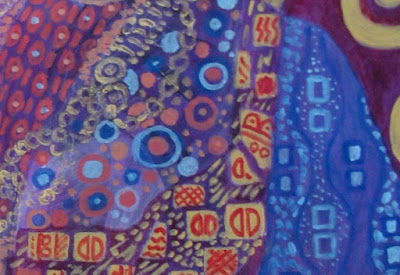Right off the bat, who is the artist whose work most lends itself to a large Zentangle colouring book? (But first, a swerve off-topic: Why wasn't I savvy enough at age 7 to "monetize" those childhood black-and-white outline doodles that I then coloured in? I guess it took even more savvy grown-ups like the couple described in this link).
Did you guess? Gustav Klimt, of course, with his abundant mesmerizing patterns. Everyone knows Klimt, I think. Whether or not you do, this 2-minute video on his famous so-called "Woman in Gold" ("Portrait of Adele Bloch-Bauer") is a brief overview of the painting, the subject, the eccentric artist, and the 21st-century court case that arose from its having been confiscated by the Nazis.
When I saw Klimt on the curriculum of my on-line art course, I knew I had the perfect subject in a figure I'd happened upon months before in Google Images -- the 19th-/early 20th century stage and silent film actress Edith Wynne Matthison.
And I knew I'd better get an early start! As I worked back and forth between Wynne Matthison and Klimt, a new question arose every session. This was not as simple as colouring a Zentangle design!
For a start, what are Klimt's typical patterns? Does he combine different geometrical shapes?
Answer: There's nothing "typical" about how he bends and combines shapes in endless variations -- and somehow it all looks coherent.
Q: How does he use colour? Are backgrounds solid or patterned?
A: A little bit of this, a little bit of that -- sometimes shades of a single colour, sometimes colour opposites, sometimes a little breather of solid colour. It's all dynamite.
Q: To what extent do his patterns suggest direction and 3-dimensionality?
A: Sometimes they do --very subtly; sometimes the whole expanse of pattern is just flat.
Q: How did he make such perfect geometrical shapes, especially the swirls?
A: I don't know, and I gave up trying.
Q: Does scale matter?
A: You bet. It HAS to have been easier to apply patterns to a 54"-square piece like the "Woman in Gold" than to work with a tiny paintbrush on an 11" x 17" surface like mine.
It was alternately exhilarating and mind-numbing to cast Edith Wynne Matthison as a Klimt heroine, and here's her curtain call. (Developmental sequence shown here, worked over an old quick sketch of a dancer in action).
On one of the exhilarating mornings, I went out in the garden after my studio session and was struck by how the Sweet William and pansies looked JUST like a Klimt painting! I was so excited that I staged the little setting shown in the title photo -- and then remembered when I came inside that Klimt had been there before me, with his own paintings of flowers and gardens.
Final question: What does it take to persevere in painting these meticulous patterns? Well, I guess you have to be a Klimtomaniac. (Applause and laughter from the audience)
And if you're not there yet, you might be after viewing how one contemporary museum is presenting Klimt as an "immersive experience." (Click on the white dots in the first frame to move through the exhibit)










No comments:
Post a Comment